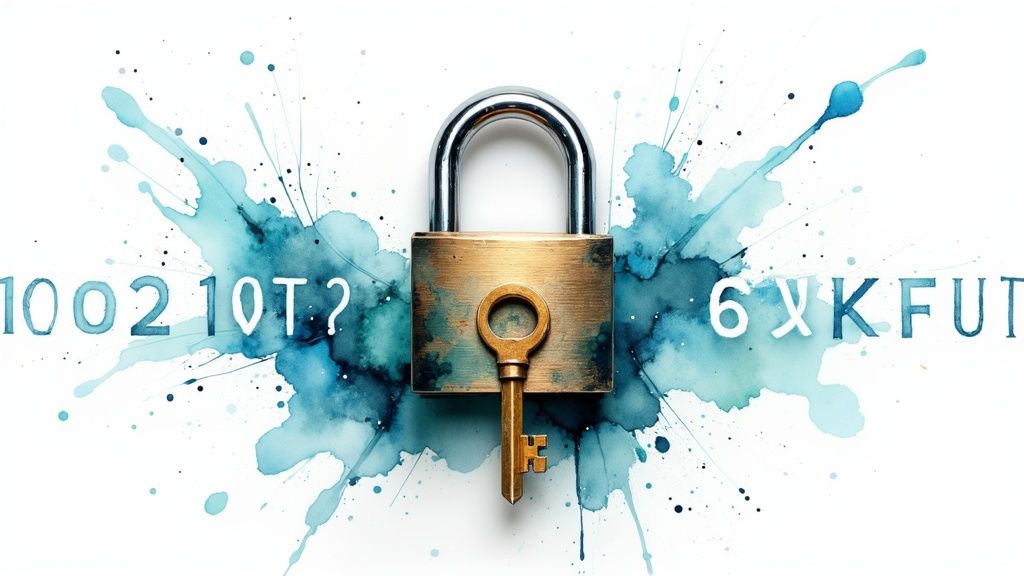What Is Encryption and How Does It Work?
What is encryption? A simple guide to how it works, why you need it, and how it protects your data from prying eyes. Secure your digital life today.


What is encryption? A simple guide to how it works, why you need it, and how it protects your data from prying eyes. Secure your digital life today.


Encryption is, at its core, a digital secret code. It’s the process of scrambling your data so it becomes completely unreadable to anyone who doesn’t have the specific key to unlock it. Think of it like a locked diary in the digital world—it’s the invisible shield protecting your online life.
Table of Contents
Let's cut through the noise. I've sat through enough meetings where consultants throw around "end-to-end encryption" like it's some magic spell that solves every security problem. The truth is, it’s not magic—it's just a very, very good lock.
Imagine you're sending a sensitive company memo. Unencrypted, that memo is like a postcard; anyone who intercepts it along the way can read the whole thing. Good luck explaining that data breach to your board.
Encryption takes that postcard and shoves it inside a titanium safe that can only be opened with a unique key. This process turns your readable message, or plaintext, into a jumbled mess of gobbledygook called ciphertext. Anyone who peeks at it now sees gibberish, not your Q4 financial projections.
This isn’t just for spies and blockbuster movie plots. It’s the baseline, the absolute table stakes for any business that takes its data seriously. From the morning coffee you order on an app to the payroll files sitting on your server, encryption is the silent guardian working behind the scenes.
You don't need a computer science degree to get this, but you do need to grasp three fundamental concepts. I’ve seen teams get this wrong, and it’s always a painful cleanup job.
The entire security of modern encryption doesn't rely on keeping the method secret, but on keeping the key secret. That's the one thing you have to protect like it's your first-born child.
Getting a handle on these basics is non-negotiable. For a deeper dive into foundational concepts, you can find valuable resources to help you learn more about digital security and encryption.
We've built entire products on these principles, and for more insights into the tech landscape, feel free to check out the other articles on the https://clouddevs.com/blog/. Toot, toot! This one concept is the first step to truly understanding modern internet security.
Encryption isn't some new-fangled tech trend cooked up in a Silicon Valley garage. It’s an ancient practice—the original information security—and its story is way more interesting than you’d think. This isn't just a history lesson; it's the origin story of your digital privacy.
The desire to keep messages secret is as old as writing itself. Seriously. The earliest known use of this stuff dates back over 3,900 years to ancient Egypt, where craftsmen used non-standard hieroglyphs to protect their trade secrets. It was less about national security and more about making sure the guy in the next town over didn't steal your killer new pottery glaze recipe.
From there, it evolved. You had Roman generals like Julius Caesar using simple substitution ciphers to protect military commands. If his messengers were captured, the enemy would just find a bunch of gibberish. A low-tech but brutally effective way to maintain an edge on the battlefield.
Fast forward a couple of millennia, and the stakes got exponentially higher. During World War II, cryptography wasn't just a clever trick; it was a cornerstone of military strategy. The German Enigma machine was a beast—a complex electromechanical device that created ciphers so tough they were considered unbreakable.
Breaking that code became one of the Allies' biggest obsessions. It took a heroic effort from Polish and British codebreakers, including the legendary Alan Turing, to finally crack it.
This wasn't just some academic puzzle. Cracking Enigma is widely credited with shortening the war by years and saving countless lives. It was a stark lesson in just how powerful—and critical—strong encryption could be.
This monumental achievement showed the world that cryptography would define the future of information warfare and, eventually, digital security for everyone.
After the war, the action moved from secret bunkers to corporate and government labs. The digital revolution of the 1970s was the real turning point. IBM developed the Data Encryption Standard (DES) in 1975, which quickly became the official U.S. government standard. It was good for its time, but its 56-bit key eventually became vulnerable as computing power grew.
Then, just a year later, Whitfield Diffie and Martin Hellman introduced the mind-bending concept of public-key cryptography. This solved the age-old problem of how to securely share a secret key in the first place. These breakthroughs laid the essential groundwork for nearly every secure digital interaction we have today. You can find out more about the history of cryptography on IBM.com to see how these milestones shaped modern security.
Alright, let's get into the two main flavors of encryption without making your eyes glaze over. I’ve seen teams get tripped up here, picking the wrong tool for the job and creating security holes you could drive a truck through. Getting this right is fundamental.
First up is symmetric encryption. Think of it like the key to your house. You use the exact same physical key to lock the door when you leave and to unlock it when you get back. It's one key to rule them all.
This method is blazing fast and efficient. When you’re just encrypting files on your own hard drive or a database that only one system needs to access, symmetric is your go-to. It’s simple, strong, and gets the job done without a lot of computational overhead.
The infographic below shows a simple visual comparison between the single-key approach of symmetric encryption and the dual-key system of asymmetric encryption.
The visualization highlights the core difference: symmetric uses identical keys for locking and unlocking, while asymmetric relies on a matched but distinct public and private key pair.
So, what's the catch with symmetric encryption? The problem rears its ugly head the moment you need to share that key with someone else. How do you securely get your house key to a friend across the country? If you just mail it, anyone could intercept it. That’s the exact dilemma with symmetric keys—a massive, logistical nightmare known as the key distribution problem.
This is where asymmetric encryption strolls in like the hero in a spy movie. It cleverly uses a matched pair of keys: a public key and a private key.
The classic analogy is a mailbox. Anyone can drop a letter into the mail slot (using the public key), but only you, the owner with the physical key (the private key), can open the box and read the letters.
This solves the key-sharing problem beautifully. You can shout your public key from the rooftops, and your data remains perfectly safe because only your private key can decipher the messages it encrypts.
While asymmetric encryption is a genius solution for secure communication, it's also much slower and more computationally intensive than its symmetric counterpart. This performance difference is crucial. You wouldn't want to encrypt a massive database with it; you'd be waiting until next Tuesday for it to finish.
To really nail down the differences, let's put these two side-by-side. Seeing their unique strengths and weaknesses makes it clear why they're used in different scenarios.
| Feature | Symmetric Encryption (One Key) | Asymmetric Encryption (Two Keys) |
|---|---|---|
| Number of Keys | One shared secret key for both encryption and decryption. | A pair of keys: one public (for encryption), one private (for decryption). |
| Speed | Fast. Low computational overhead, great for large data volumes. | Slow. Computationally intensive, not ideal for bulk encryption. |
| Key Management | Difficult. Securely sharing the single key is a major challenge. | Easy. The public key can be shared openly without any risk. |
| Primary Use Case | Encrypting data at rest (files, databases, full-disk encryption). | Secure key exchange, digital signatures, and authenticating identity. |
| Common Algorithms | AES, Blowfish, DES, RC4. | RSA, Diffie-Hellman, ECC (Elliptic Curve Cryptography). |
| Real-World Analogy | A single house key that both locks and unlocks the same door. | A public mailbox with a slot for anyone to drop letters in, but only one private key to open it. |
Ultimately, it's not a competition. In the real world, we don’t choose one over the other—we use both, playing to their strengths.
A typical secure connection, like when you visit your banking website, uses asymmetric encryption first to securely share a brand-new, one-time-use symmetric key. Once that secret key is safely exchanged, the rest of the session switches over to the faster symmetric encryption. It’s a hybrid approach that gives you the best of both worlds: secure key exchange and high-speed data protection.
If encryption had a heavyweight champion, it would undoubtedly be the Advanced Encryption Standard, or AES. This isn’t just some obscure algorithm for tech nerds to geek out over; it’s the digital equivalent of Fort Knox, trusted by governments, banks, and intelligence agencies to protect their most sensitive secrets.
Before AES entered the ring, the reigning champ was the Data Encryption Standard (DES). In its day, DES was solid. But as computing power exploded, its 56-bit key started looking less like a bank vault and more like a bicycle lock in an era of plasma cutters.
The writing was on the wall in 1999 when a team cracked DES in just over 22 hours. Let that sink in. The standard protecting critical data could be broken in less than a day. That wasn't just a red flag; it was a five-alarm fire signaling that the digital world needed a much, much bigger lock.
So, what makes AES the undisputed king? It boils down to a brilliant combination of elegant design and brute mathematical force. Unlike its predecessor, AES offers different key lengths, giving you options depending on your level of paranoia (or regulatory requirements).
To put AES-256 in perspective, trying to brute-force it—that is, guessing every single possible key combination—would take the world's most powerful supercomputers billions of years. Longer than the current age of the universe. It’s not just impractical; it’s physically impossible with any technology we can foresee.
Don't overthink it. For 99% of business applications, AES is the answer. It’s the battle-tested, globally accepted standard for a reason.
This transition to a stronger standard couldn't have come at a better time. The world generated around 120 zettabytes of data in 2023 alone, and with cybercrime costs projected to hit $10.5 trillion annually by 2025, weak encryption is a catastrophic liability. Today, an estimated 95% of encrypted internet traffic relies on AES or similar advanced ciphers, making it the bedrock of modern digital trust. For a closer look at the transition, you can explore the history of DES and the rise of AES.
You don't need to be a cryptographer to appreciate what AES does for you. It's working silently behind the scenes every single day, protecting your Wi-Fi connection (WPA2/3), securing the files on your smartphone, and encrypting your data in the cloud. It’s the invisible, unbreakable shield that makes the modern digital world possible.
If you think encryption is just for spies and shadowy government agencies, think again. It’s the unsung hero working behind the scenes for you all day, every day, and you probably don’t even notice. It's not some abstract concept; it's a fundamental utility, like the plumbing in your house.
See that little padlock icon in your browser's address bar? That’s SSL/TLS encryption in action. It’s the only thing standing between your credit card details and some hacker’s shopping spree when you buy that questionable novelty mug online. Without it, e-commerce would grind to a halt.
Ever wonder how your WhatsApp or Signal chats stay just between you and your friends? That’s the magic of end-to-end encryption. Not even the company that runs the app can read your messages about last night's terrible date. They hold the encrypted package, but they simply don't have the key to open it.
This same principle applies to your devices. That stolen company laptop? If you used full-disk encryption, it's just an expensive, shiny paperweight to a thief. They can have the hardware, but the data—your customer lists, financial reports, and trade secrets—remains a garbled mess they can't use.
It’s simple: encryption transforms a catastrophic data breach into a mere inconvenience of lost hardware. One is a PR nightmare; the other is just an expense report.
And what about that VPN you use to watch your favorite streaming service from another country? It’s not just for geo-hopping. A VPN creates a secure, encrypted tunnel for all your internet traffic, hiding your activity from your internet provider and anyone else snooping on the network.
From protecting your personal information on social media to securing vast corporate databases, encryption is the silent guardian of our digital lives. For businesses, getting a handle on these security mechanisms is crucial, especially when considering the various new cloud computing security benefits available today. The bottom line is that encryption isn't an optional feature anymore; it’s a non-negotiable part of modern life.
So, we've walked through the "what" and the "how." Now, let's get down to the part that really matters to your business: why should you actually care about any of this?
To put it bluntly, skipping on encryption is like leaving your office front door wide open overnight with a sign that says "Help Yourself." You're just asking for trouble.
This is way more than just checking a compliance box. At its heart, encryption makes three promises your business absolutely cannot live without: privacy, integrity, and trust. It's the digital lock that keeps your team's Slack DMs from becoming front-page news. It’s also what guarantees the wire transfer you just sent to a new contractor actually lands in their bank account, not a hacker's.
For any modern business, this isn't just a "good practice"; it's frequently the law. And trust me, you don't want to get on the wrong side of regulators—they aren't messing around.
Standards like GDPR in Europe and HIPAA in the U.S. healthcare space make strong encryption completely non-negotiable. A breach isn’t just a bad day at the office; it’s a potential multi-million dollar fine and a public relations nightmare that can absolutely sink your brand.
I've seen too many startups treat encryption as a "nice-to-have" feature they'll get around to later. That's a catastrophic mistake. It's not a cost center; it's a foundational investment in your company's survival and your customers' loyalty.
When people hand over their data, they are placing their trust in you. Break that trust, and you'll probably never get it back.
Think about the talent you want to attract, too. The best engineers won't stick around a place that's casual about security. If you're building a team, our guide on how to hire remote developers really drives home the importance of finding professionals who get what's at stake.
So, why care? You care because your customers do. Your partners do. And most importantly, the regulators with the power to levy crippling fines definitely do. Encryption is your first, best, and most essential line of defense in a world that’s always trying to break down your door.
Alright, let's wrap this up by tackling a few questions that always seem to pop up. No fluff, just the straight answers I wish I’d had when I was starting out.
Theoretically? Sure, in the same way a meteor could theoretically land on your desk. Practically, for modern standards like AES-256, it's a resounding no. The sheer amount of computing power required to brute-force it is beyond anything we can build.
It would take the world’s fastest supercomputers billions of years. So unless your attacker has a time machine, your data is safe.
Nope. This one trips people up all the time. A VPN is a service that uses encryption to create a secure, private tunnel for your internet traffic.
Think of encryption as the steel that makes a safe, while the VPN is the entire armored truck service that moves your valuables. One is the technology; the other is the application of that technology.
The bottom line is that encryption is the fundamental tool, but how you implement it matters. A sloppy implementation is like having the world’s best lock on a cardboard door.
Ensuring your encryption strategy is solid from the ground up is crucial, and it’s a core part of building a robust software project development plan that won’t give you headaches later.

Choosing between contract vs direct hire? This guide helps you decide. Explore costs, flexibility, and compliance for hiring LATAM developers.

Discover the top 12 software development contract sample strategies and tips. Complete guide with actionable insights.

A no-fluff guide to hiring offshore developers. Learn the real-world process, from vetting talent to managing payroll, without the usual corporate nonsense.


